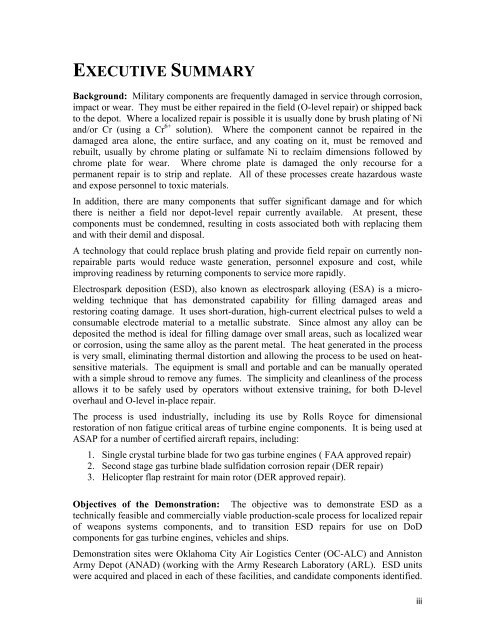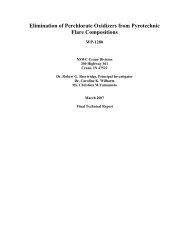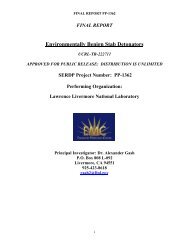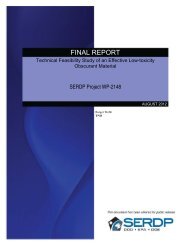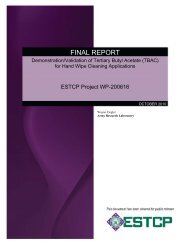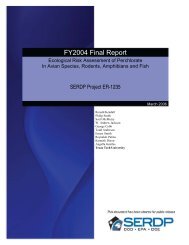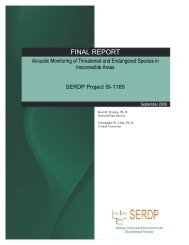Final Report - Strategic Environmental Research and Development ...
Final Report - Strategic Environmental Research and Development ...
Final Report - Strategic Environmental Research and Development ...
Create successful ePaper yourself
Turn your PDF publications into a flip-book with our unique Google optimized e-Paper software.
EXECUTIVE SUMMARY<br />
Background: Military components are frequently damaged in service through corrosion,<br />
impact or wear. They must be either repaired in the field (O-level repair) or shipped back<br />
to the depot. Where a localized repair is possible it is usually done by brush plating of Ni<br />
<strong>and</strong>/or Cr (using a Cr 6+ solution). Where the component cannot be repaired in the<br />
damaged area alone, the entire surface, <strong>and</strong> any coating on it, must be removed <strong>and</strong><br />
rebuilt, usually by chrome plating or sulfamate Ni to reclaim dimensions followed by<br />
chrome plate for wear. Where chrome plate is damaged the only recourse for a<br />
permanent repair is to strip <strong>and</strong> replate. All of these processes create hazardous waste<br />
<strong>and</strong> expose personnel to toxic materials.<br />
In addition, there are many components that suffer significant damage <strong>and</strong> for which<br />
there is neither a field nor depot-level repair currently available. At present, these<br />
components must be condemned, resulting in costs associated both with replacing them<br />
<strong>and</strong> with their demil <strong>and</strong> disposal.<br />
A technology that could replace brush plating <strong>and</strong> provide field repair on currently nonrepairable<br />
parts would reduce waste generation, personnel exposure <strong>and</strong> cost, while<br />
improving readiness by returning components to service more rapidly.<br />
Electrospark deposition (ESD), also known as electrospark alloying (ESA) is a microwelding<br />
technique that has demonstrated capability for filling damaged areas <strong>and</strong><br />
restoring coating damage. It uses short-duration, high-current electrical pulses to weld a<br />
consumable electrode material to a metallic substrate. Since almost any alloy can be<br />
deposited the method is ideal for filling damage over small areas, such as localized wear<br />
or corrosion, using the same alloy as the parent metal. The heat generated in the process<br />
is very small, eliminating thermal distortion <strong>and</strong> allowing the process to be used on heatsensitive<br />
materials. The equipment is small <strong>and</strong> portable <strong>and</strong> can be manually operated<br />
with a simple shroud to remove any fumes. The simplicity <strong>and</strong> cleanliness of the process<br />
allows it to be safely used by operators without extensive training, for both D-level<br />
overhaul <strong>and</strong> O-level in-place repair.<br />
The process is used industrially, including its use by Rolls Royce for dimensional<br />
restoration of non fatigue critical areas of turbine engine components. It is being used at<br />
ASAP for a number of certified aircraft repairs, including:<br />
1. Single crystal turbine blade for two gas turbine engines ( FAA approved repair)<br />
2. Second stage gas turbine blade sulfidation corrosion repair (DER repair)<br />
3. Helicopter flap restraint for main rotor (DER approved repair).<br />
Objectives of the Demonstration: The objective was to demonstrate ESD as a<br />
technically feasible <strong>and</strong> commercially viable production-scale process for localized repair<br />
of weapons systems components, <strong>and</strong> to transition ESD repairs for use on DoD<br />
components for gas turbine engines, vehicles <strong>and</strong> ships.<br />
Demonstration sites were Oklahoma City Air Logistics Center (OC-ALC) <strong>and</strong> Anniston<br />
Army Depot (ANAD) (working with the Army <strong>Research</strong> Laboratory (ARL). ESD units<br />
were acquired <strong>and</strong> placed in each of these facilities, <strong>and</strong> c<strong>and</strong>idate components identified.<br />
iii


